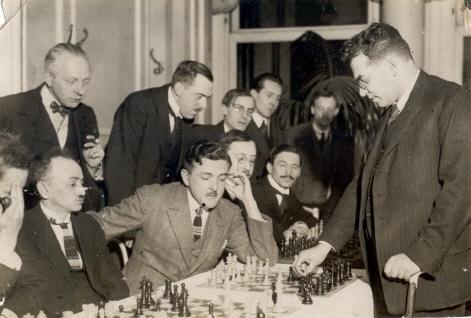
Edward Winter

Richard Réti (C.N. 4690)
From J.W. Harper (Harrogate, England):
‘Do you know the source of Réti’s often misquoted remark on visualization at New York, 1924? It must be often misquoted since it is given in so many different forms. After his fifth-round defeat of Capablanca, both players are said to have been interviewed by a journalist who asked them the non-player’s usual question, how many moves they saw ahead. Capablanca is quoted as claiming ten (did he really say such a silly thing?). Réti’s reply is variously given as “usually only one” or “usually not even one” or “only one, but it is always the best one”, etc. What did he say? Or is the story apocryphal?’
(837)
In C.N. 856 two correspondents, Bernard Cafferty (Hastings, England) and G.H. Diggle (Hove, England), referred to Réti’s Modern Ideas in Chess (see C.N. 6898 below). Hugh Myers (Davenport, IA, USA) noted the appearance of Charles Jaffe’s name in connection with a version of the story.
Page 30 of Chess Pieces by Norman Knight (London, 1949) reported that, when asked by a lady at a Hastings Congress how many moves he was accustomed to thinking ahead, Sir George Thomas replied, ‘Madam, I am content with the move immediately ahead’.
Steinitz’s answer to a similar question appeared on pages 316-317 of K. Landsberger’s book on him (Jefferson, 1993). Steinitz said that it depended on who his opponent was:
‘The stronger the opponent, the more moves I can foresee because he makes the correct moves. With a weak player, I anticipate one or two moves and plan my responses. I am constantly thinking, “If he does this, then I’ll of course do that”.’
On page 64 of the November 1989 Playboy, Kasparov stated:
‘It depends on the nature of the position. Chess is a complicated game. But in positions where everything is forced – one move, one answer – I can calculate something between ten and fifteen moves ahead. But that happens very rarely. Usually, the positions are more complicated than that – one move, then five answers, each of them having five answers. You have to use your intuition in cases like that, your positional understanding. It’s very good if you can calculate five, six, maybe seven moves ahead.’
(1995)
From Louis Blair (Keyser, WV, USA):
‘I.A. Horowitz (1907-73) was fond of telling the story of a “New York expert”, who, after winning a game against Capablanca, explained that although he looked ahead one move “it is always the best move”. (See, for example, page xi of How to Think Ahead in Chess.) On page 164 of All About Chess, Horowitz referred to the “best move” player as “New York’s East-side pride”, which suggests Charles Jaffe, who won a tournament game against Capablanca (New York, 1913).’
(2085)
Louis Blair submits a claim in a column entitled ‘The Chess Board’ in the Philadelphia Sunday Times of 1 June 1890, where E.L. Townsend was quoted as follows: ‘In November 1858 ... I asked Mr Morphy how he regarded Harrwitz as a chess expert. He replied: “Mr Harrwitz plays chess as well as myself, but I think my advantage lies in the fact that I can see eight moves ahead when he only sees seven moves”.’
It is worth recalling here the words of G.H. Diggle on pages 635-636 of the December 1980 BCM:
‘… [in 1865] Staunton (over a decade after his retirement from the Chess Player’s Chronicle and a quarter of a century after launching the magazine) suddenly reappeared as Editor of a new periodical – the Chess World. But both the actual “Chess World” and Staunton himself had aged since he brought out his first number of the Chronicle. Then he was a young and adventurous pioneer, the hero of adventurous followers – now, a long deposed and ailing monarch. Though actually only 55 years old, his heart trouble frequently forced him to lay aside his pen; and the frustration caused by his physical state being no longer able to cope with the demands of his vigorous intellect had turned him into something very like Henry VIII in his last phase. While he could still comment on occasion with shrewdness and penetration on the chess affairs of the day (in particular the Steinitz-Anderssen match of 1866) he became more and more caustic and unfair to the younger generation, both in the Chess World and his weekly Illustrated London News column.’
(2891)
Page 19 of Every Move Must Have a Purpose by Bruce Pandolfini (New York, 2003) has a claim that was new to us:
‘At the great New York tournament in 1924, world champion José Raúl Capablanca (1888-1942) impishly informed a reporter that he often analyzed 50 moves into the future.’
(3097)
Edward Hamelrath (Dresden, Germany) draws attention to a recent chess article by Philip E. Ross in the Scientific American which is available online.
As regards the statement attributed to Capablanca that he saw only one move ahead but always the correct one, now we see that in an earlier source (Chess Review, May 1946, page 34) Horowitz named Jaffe:
‘Apropos is the story of the game between the invincible Capablanca and Charles Jaffe, pride of the East Side. Capa forgot he was invincible: he lost. A reporter who was present asked the Cuban, “How far do you see ahead?” Capa replied impressively, “About ten moves”. Then the reporter went over to Jaffe: “How far do you see ahead?” Much to everyone’s surprise, the reply was, “Only one move”. This didn’t make sense. “How could a player who can see only one move ahead defeat another who can delve so deeply?” Here Jaffe explained: “I see only one move ahead, but always the best move.”
That is sufficient.’
Whether these alleged exchanges ever occurred (i.e. after Jaffe’s win over Capablanca at New York on 2 February 1913) is far from clear, but perhaps a reader could, on the off chance, look in the press of the time.
(4483)
From page 70 of the Dictionary of Modern Chess by Byrne J. Horton (New York, 1959):
‘When Janowsky was asked how far he saw ahead, he replied: “Only one move – the best move.”’
On what basis was the famous rejoinder attributed to Janowsky?
(5320)
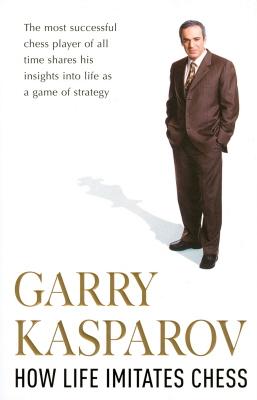
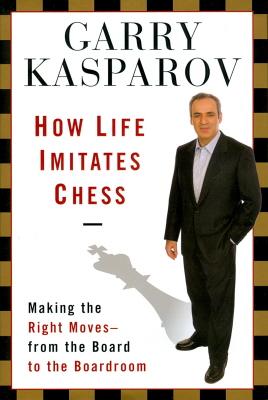
Heinemann (London) and Bloomsbury (New York editions)
The principal weakness of How Life Imitates Chess by Garry Kasparov (London and New York, 2007) relates to its own use of quotes ... The heading to chapter 5 of Heinemann on page 53 (page 48, chapter 4 in the case of Bloomsbury) professes to cite Capablanca: ‘I see only one move ahead, but it is always the correct one.’ No source is given, of course, because none is known, and that of itself should have resulted in the quote being expunged. Are there not enough authenticated chess observations to choose from?
(5375)
From page iv of Réti’s Masters of the Chess Board (New York, 1932), in H.R. Bigelow’s Introduction:
‘There is an anecdote told to the effect that Réti was once asked how far ahead he had to calculate in a serious contest. “Only two moves!”, he replied to the astonished inquirer. This is an exaggeration, of course, but it is certainly true that once the principles of the selected opening are properly grasped, the correct sequence of moves becomes more or less automatic.’
From the Introduction (page vii) to Lessons in Chess Strategy by W.H. Cozens (London, 1968):
‘How many moves ahead can you see?
This question is frequently put to chessmasters. Réti’s famous reply “Usually not one!” is often regarded as a witticism, but after a little thought about the complex structure of chess one may perhaps conclude that he was speaking something alarmingly near to literal truth.’
(6892)
Luc Winants (Boirs, Belgium) notes this passage on page 5 of Réti’s Modern Ideas in Chess (London, 1923):
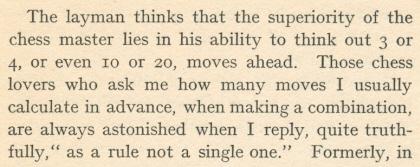
We add the text from page 6 of the original German edition, Die neuen Ideen im Schachspiel (Vienna, 1922):
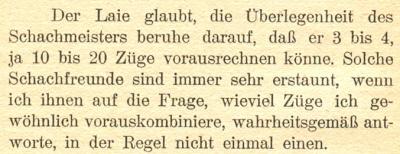
(6898)
From an article by Leander Turney entitled ‘Chess Instinct’ on pages 208-209 of the September 1914 American Chess Bulletin:
‘It is said that a lady once admiringly asked Zukertort how many moves he could see ahead, and that he replied, “Madam, if the position is sufficiently simple, and I look a long time, I can sometimes see ‘one’ move ahead.”’
The story being prefaced by both ‘it is said’ and ‘once’, particular caution is obviously necessary.
(7090)
In Chess is Chess by Aleksandar Matanović (Belgrade, 1990) the main source often seems to be thin air. A variant of the ‘Looking one move ahead’ claims is on page 16:
‘When Reshevsky was asked how he managed to triumph over his opponents, he said: “Nothing to it. I just see one move ahead of my opponent.”’
(9013)
Below is a brief article by Vera Menchik in the Daily Mail, 5 August 1927, page 8:

(9074)
Brian Karen (Levittown, NY, USA) notes the following passage from an article by Herman Steiner on page 5 of Chess Life, 20 March 1953:
‘When my students ask me how many moves ahead a master can see, I tell them the following story: During one of the international tournaments, where the great Capablanca played, a newspaper reporter asked “Capa” how many moves ahead he could see. It seems that the reporter had read somewhere that a great master could see as many as 30 moves ahead. “Capa” very modestly said, “Not quite 30, but about 20.” His next opponent was Charles Jaffe, a fine player, but by no means in his class. In this encounter, after working out a winning position, “Capa” failed to make the best move. Jaffe promptly took advantage by sacrificing his queen, and eventually his famous opponent resigned. (Incidentally, this was the only game “Capa” lost during this tournament.)
This naturally created a great furore, and now the same reporter came to visit Jaffe. He asked the same question, namely, how many moves he could see ahead. Jaffe calmly answered: “Two moves ahead.”
“What!” cried the reporter. “Impossible! Your famous opponent told me, before the game started, that he could see about 20 moves ahead.”
“Did he?” said Jaffe calmly. “I still insist that I can see only two moves ahead – but two good ones.”’
From pages 429-430 of 1000 Best Short Games of Chess by Irving Chernev (New York, 1955):
‘Chess masters are wont to answer flippantly to the layman’s question, “How far ahead do you calculate, when making a combination?” They either say, like Réti, “As a rule, not a single move”. Or, like Jaffe, “I think one move ahead – but it is always the best move!”
The records show that the great master does see many moves ahead – and accurately, as otherwise his whole combination would fail.’
Page 39 of Winning Chess Tournaments by Robert M. Snyder (Lincoln, 2007) had another variation:
‘I once heard a story where a reporter asked the famous master Jose Capablanca, “How many moves do you see ahead?” He jokingly said, “Fifty!” The reporter, not knowing much about chess, wrote that down in his notes and then proceeded to ask another famous master, Richard Réti, the same question. Réti said, “One! But always the right one.” There is something to be learned from this: You only need to see as deep as necessary to establish the best move for the position.’
(10014)
C.N. 9074 (see above) showed an article by Vera Menchik on page 8 of the Daily Mail, 5 August 1927 in which she wrote:
‘When, for instance, I am asked how many moves I think ahead, I must, if I am truthful, give the same answer as that of the celebrated Czechoslovakian player Richard Réti: “Not even one move.”’
On page 265 of the 1 December 1947 issue of Chess World C.J.S Purdy introduced an article by Lajos Steiner, ‘How Many Moves Can You See Ahead?’, as follows:
‘Here is an entertaining article by the Australian champion, dealing with a question that every chess expert is asked ad nauseam. When a reporter asked it of the late Vera Menchik, she replied, “Oh, about one”. When another reporter asked it of the late Richard Réti, his dramatic sense got the better of him and he replied, “As a rule, not a single one”. Lajos Steiner gives a less cryptic reply’.
In his article, published on pages 265-266, Steiner wrote:
‘How far ahead to see? It is a question that everyone can answer for himself at the proper time, if he tries to approach positions with an open, critical mind. And that is the most important thing in a game of chess. It is better if we do not waste any more space at this juncture, and rather look at two positions.’
The diagrams given by Steiner:
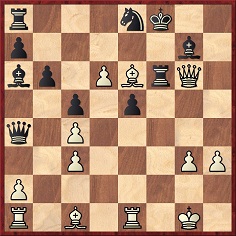
White has a move which wins immediately

White mates in 90 moves
After outlining the solution to the second position, Steiner wrote:
‘An interesting piece of work, but the 90 moves of it are not much more difficult to see than the single move of the previous example.’
Steiner mentioned only that the problem was by Béla Bakay of Budapest, and we shall welcome further particulars. It is not one of the Bakay compositions in Ungarische Schachproblemanthologie by György Bakcsi (Budapest, 1983).
A future C.N. item will revert to the mate-in-90 problem, but the present item focuses on the first position. The game (Gerald Abrahams v František Zíta, London, 14 June 1947) was played on the first day of a two-round match between Great Britain and Czechoslovakia. From page 212 of the July 1947 BCM:
‘Abrahams succeeded in engineering one of his typical slashing attacks which apparently was quite sound, for on the 26th move ... he actually had an immediate win by a sensational queen’s sacrifice, first indicated by Professor Penrose.’
The game was annotated by Abrahams on pages 14-18 of The Czechs in Britain by W. Ritson Morry (Birmingham, 1947). From page 15:
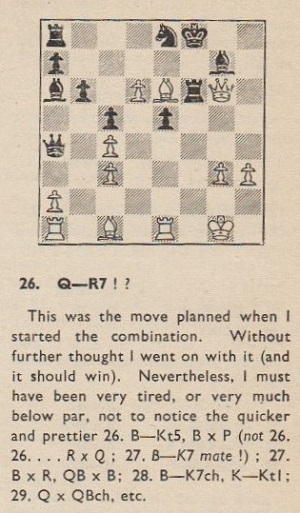
Abrahams gave the position (‘The game can be finished quickly by B-Kt5!’), mentioning neither the players nor the occasion, on pages 70-71 of The Chess Mind (London, 1951), although that information was added on page 72 of the Penguin edition (Harmondsworth, 1960).
(10035)
The article by Lajos Steiner referred to in C.N. 10035 (Chess World, 1 December 1947, pages 265-266):
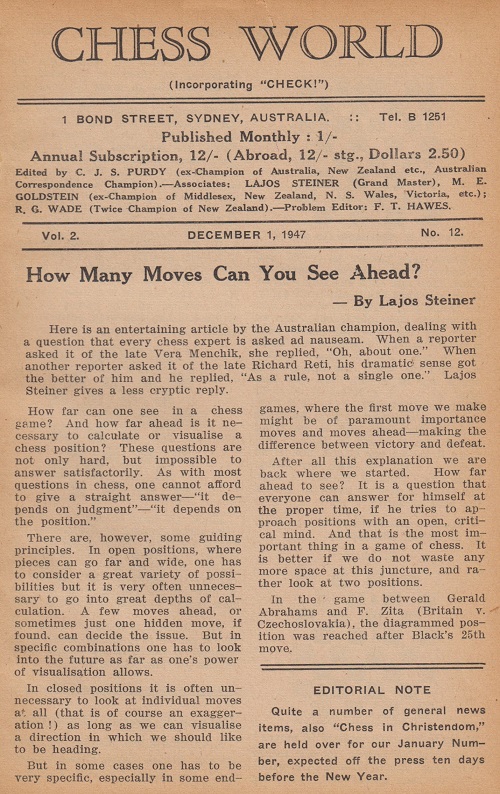
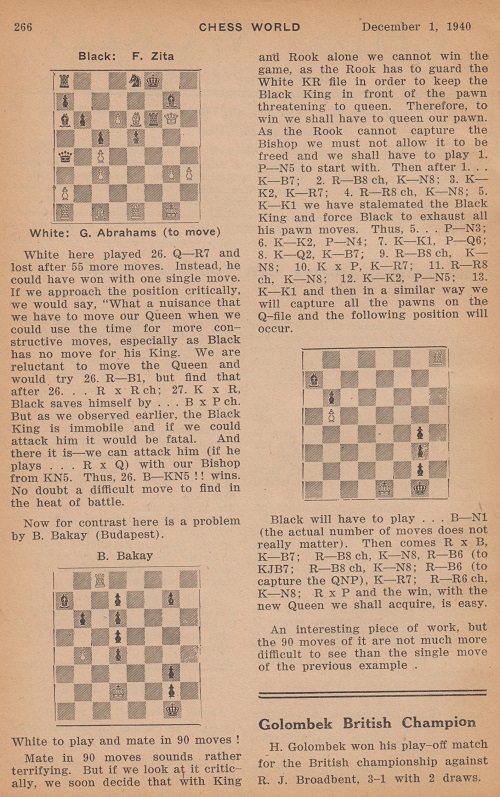
The details on where Béla Bakay’s mate-in-90 problem first appeared have not yet been found.
(10061)
Regarding the Bakay composition, in C.N. 12024 Lindsay Ridland (Edinburgh) pointed out a motif which secures Black a draw: 10…Bb8 11 Rxb8 Kf2 12 Rf8+ Ke1.
From page 15 of American Chess World, January 1902:
‘Anderssen, the chess expert, was once asked by a lady how far ahead he could see in a game of chess, and he replied that when he tried very hard he could see one move ahead.’
A ‘once’ version involving Zukertort and another, or perhaps the same, lady was quoted in C.N. 7090 from pages 208-209 of the September 1914 American Chess Bulletin:
‘It is said that a lady once admiringly asked Zukertort how many moves he could see ahead, and that he replied, “Madam, if the position is sufficiently simple, and I look a long time, I can sometimes see ‘one’ move ahead.”’
(10180)
To the Chess Notes main page.
To the Archives for other feature articles.
Copyright: Edward Winter. All rights reserved.